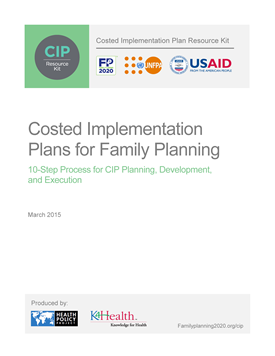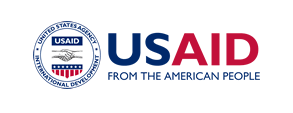The Health Policy Project ended in 2016. Work continued under Health Policy Plus (HP+) until 2022.
FP2020

Futures Group/FP2020
Overview
Family Planning 2020 (FP2020) generated global commitments to make high-quality, voluntary family planning services, information, and supplies more available, acceptable, and affordable for an additional 120 million women and girls in the world’s poorest countries by 2020. FP2020 illustrates the growth of global, regional, and national interest in family planning, which is accompanied by increased financial commitments from global partners and domestic resources. FP2020 emphasizes the principle of increasing political commitment and country ownership in implementation.
What We Do
The Health Policy Project (HPP) continues helping the international community define what policy changes are needed for countries to achieve global health commitments and goals, how to best support advocates’ efforts to contribute substantively to better health outcomes, and how to keep family planning programs respectful of rights while addressing FP2020 goals. HPP has:
- Developed tools and approaches in collaboration with other Costed Implementation Plan (CIP) experts that facilitate the planning, development, and execution of CIPs –tools address a range of topics from setting up a CIP Taskforce and engaging stakeholders, to designing a prioritized technical strategy, and costing planned activities.
- Built capacity in costing and finance to support the development and execution of costed implementation plans for FP2020 and Ouagadougou Partnership commitments, for example, working with the MOH in Zambia to build its capacity to cost and monitor that country’s FP2020 commitments, and assess the gap between resources available and those required to fully execute their plan.
- Worked in close collaboration with ministries of health and civil society partners to develop comprehensive, strategic, country-owned national costed implementation plans for family planning that support achievement of Ouagadougou Partnership commitments and FP2020 pledges. With HPP’s assistance, 8 countries have now completed national CIPs.
- Convened members of parliament, ministry of health officials and civil society representatives from Ethiopia, Ghana, Malawi and Uganda to foster joint accountability for FP2020 by developing one-year country advocacy action plans. Key themes from the action plans include improving multi-sectoral coordination for improving youth services, increasing domestic funding for FP and addressing human resource challenges. HPP, with its partner, PPD ARO will provide follow-up support to country delegates as they work to achieve their goals.
News
Government of Malawi Launches the Malawi Family Planning Costed Implementation Plan, 2016–2020
Government of Uganda launches the Uganda Family Planning Costed Implementation Plan, 2015–2020
Federal Ministry of Health of Nigeria Launches the Nigeria Family Planning Blueprint (Scale-Up Plan)
Publications and Resources
Costed Implementation Plan Resource Kit
Between 2009 and 2014, 16 countries developed CIPs for family planning and the international community has learned valuable lessons from these experiences. To translate these lessons and experiences into best practices for the wider family planning (FP) community, a recommended three-phase, 10-step CIP process has been prepared to guide policymakers through a CIP's development.
The CIP Resource Kit includes guidance documents and tools necessary for program planners, ministry representatives and technical assistance providers to develop and execute a robust, actionable, and resourced family planning strategy. The Resource Kit is based on best practices, drawing from the hands-on experience of governments, donors and technical assistance providers in creating and implementing CIPs. HPP tools included in the kit can be found here. The full web-based CIP Resource Kit can be accessed here.
Getting it Right: Lessons Learned for Family Planning Costed Implementation Plans
The learnings and examples presented in this brief have been informed by the combined experience of the USAID-funded Health Policy Project (HPP) and Futures Group in supporting sixteen countries to develop and implement CIPs; and by the experiences of other technical assistance providers, donors, and governments who have shared their learnings through a variety of CIP expert consultations, interviews, and public events.
Family Planning Effort Index: Scores from 1972 to 2009
Since 1972, the Family Planning Effort (FPE) Index has measured developing countries’ national family planning activities and provided a longitudinal perspective on a standardized set of program characteristics. Over eight waves of implementation, the FPE Index has contributed a unique national- and regional-level set of measures, enabling policymakers, program planners, and researchers to investigate program strengths and weaknesses, renew commitments from stakeholders, and set priorities for future improvements. The FPE Index assesses programs both with scores that reflect specific program components and with an overall total score that encompasses all program components. The USAID-funded Health Policy Project completed the 2014 wave of analyses, whose results are forthcoming
Stewardship for FP2020 Goals: Working with the Private Sector
This brief describes how ministries of health can strengthen linkages with the private sector to achieve FP2020 goals. It is part of a series of three briefs produced by the Health Policy Project to provide guidance to MOH officials and members of parliament (MPs) on three different approaches to strengthen MOHs’ stewardship functions for FP2020.
Stewardship for FP2020 Goals: The Role of Parliamentarians
This brief describes four skills that parliamentarians can develop and strengthen to become more effective at lobbying for, demanding, and securing additional funding for FP. It is part of a series of three briefs produced by the Health Policy Project to provide guidance to MOH officials and members of parliament (MPs) on three different approaches to strengthen MOHs’ stewardship functions for FP2020.
Stewardship for FP2020 Goals: MOH Role in Improving FP Policy Implementation
This brief identifies three ways for ministries of health to address barriers to policy implementation and strengthen their role as stewards of national FP2020 efforts. It is part of a series of three briefs produced by the Health Policy Project to provide guidance to MOH officials and members of parliament (MPs) on three different approaches to strengthen MOHs’ stewardship functions for FP2020.
Policy Checklist: Essential Elements For Successful Family Planning Policies
This checklist, developed by the USAID-funded Health Policy Project, draws from lessons learned and best practices moving from policy to action. It is meant to provide guidance to stakeholders on how to contribute to a policy environment that supports countries to fulfill their FP2020 commitments.
Costed Implementation Plans for Family Planning
The Health Policy Project, with various partners, has developed a collaborative, 10-step approach to creating a CIP that aligns with ongoing government planning and coordination efforts. This brief outlines these 10 steps, which when implemented, should result in a consensus-driven strategy, roadmap, and budget for achieving family planning targets under the Ouagadougou Partnership, FP2020, and/or other national programs.
Strategic Budgeting Process for Scale-Up of Family Planning: Costed Implementation Plans (CIPs) for Family Planning
This booklet, prepared by the Health Policy Project, highlights the methodology behind CIPs, walks through 10 steps for designing and implementing a national CIP for family planning, and shares experiences from seven African countries that have developed national CIPs for family planning to inform their decision making.
Costed Implementation Plans
CIPs for family planning are concrete, specific plans for achieving the goals of a national family planning program over a set number of years. A CIP details the program activities necessary to meet national goals and the costs associated with the activities, providing clear program-level information on the resources a country must raise domestically and from partners. Such plans are critical to give direction to a national family planning program.
Benin (PDF)
The Plan d’Action National Budgétisé pour le Repositionnement de la Planification Familiale 2014–2018 au Benin, published with the support of the USAID-funded Health Policy Project by the Ministry of Health, was adopted in 2013. Its objective is to increase the contraceptive prevalence rate (CPR) for women ages 15–49 years from 8.7% in 2013 (modern methods) to 20% in 2018. The plan’s strategies address demand for FP services, access to FP services, the enabling environment for FP, and monitoring and coordination.
Cameroon (PDF)
The Plan Opérationnel de Planification Familiale 2015-2020, developed with the support of the USAID-funded Health Policy Project and published by the Ministry of Health, was adopted in 2014. Its objective is to increase the contraceptive prevalence rate (CPR) for women ages 15–49 years from 16.1% in 2011 to 30% in 2020. The plan’s strategies address demand for FP services, delivery and access to FP services, the enabling environment for FP, and monitoring and coordination.
Côte d’Ivoire (PDF)
Côte d'Ivoire’s Plan d’Action National Budgétisé de Planification Familiale 2015–2020, published with the support of the USAID-funded Health Policy Project by the la Direction de Coordination du Programme National de la Santé de la Reproduction et de la Planification Familiale (DC-PNSR/PF) in the Ministry of Health, was completed in 2014. Its objective is to increase the modern CPR for all women ages 15-49 from 19.4% in 2014 to 36% in 2020. The plan’s strategies address demand for FP services, access to FP services, the enabling environment for FP, and monitoring and coordination.
Ghana (PDF)
The Ghana Family Planning Costed Implementation Plan, 2016–2020 (GFPCIP), published with the support of the USAID-funded Health Policy Project by the Government of Ghana (GoG), was launched in September 2015. The GoG has committed to increasing the modern contraceptive prevalence rate (CPR) to 29.7 per cent amongst married and 40 per cent amongst unmarried, sexually active women by 2020. The GFPCIP is structured around six main thematic areas: demand creation; service delivery; contraceptive security; policy and enabling environment; financing; and stewardship, management, and accountability. Full implementation of the GFPCIP will increase the number of women in Ghana currently using modern contraception from approximately 1.5 million users in 2015 (baseline) to 1.9 million in 2020. The total cost of fully implementing the GFPCIP, including both activity and contraceptive commodity and consumable costs from 2016–2020 are $235 million USD (906 million Ghanaian cedis).
- Download the Ghana Family Planning Costed Implementation Plan Brief (PDF)
- Download the Ghana Family Planning Costed Implementation Plan Costing File (Excel, 16 mb)
Guinea (PDF)
The Plan d’Action National de Repositionnement de la Planification Familiale en Guinée 2014–2018, published with the support of the USAID-funded Health Policy Project by the Ministry of Health and Public Hygiene, was adopted in 2013. Its objective is to increase the CPR for all women ages 15–49 from 7% in 2012 (modern methods) to 22.1% in 2018. The plan’s strategies address demand for FP services, access to FP services, the enabling environment for FP, and monitoring and coordination.
Malawi (PDF)
The Malawi Family Planning Costed Implementation Plan, 2016-2020 (FP CIP), published with the support of the USAID-funded Health Policy Project by the Ministry of Health, was launched by the government in September 2015. Full implementation of the FP CIP will result in an increase in the modern contraceptive rate from 33 percent to 60 percent by 2020. The plan addresses thematic areas that are essential for effective implementation of family planning activities including: demand generation; service delivery and access; contraceptive security; financing; policy and advocacy; stewardship and governance; and supervision, monitoring and coordination. Strategic priorities were also identified to ensure that current family planning gaps were addressed, including providing family planning information and access to services for specific groups including youth, rural populations, and the urban poor. Full implementation of the plan is also expected to avert about 2.2 million unintended pregnancies. The total cost of the plan is $94.6 million between 2016 and 2020.
Mali (PDF)
The Plan d’Action National de Planification Familiale du Mali 2014-2018, published with the support of the USAID-funded Health Policy Project by the Ministry of Health and Public Hygiene, was adopted in 2014. Its objective is to increase the CPR among women in union from 9.9% in 2013 (modern methods) to 15% in 2018. The plan’s strategies address demand for FP services, supply of FP services, the enabling environment for FP, and monitoring and coordination.
Mauritania (PDF)
The Plan d’Action en Faveur de L’Espacement des Naissances 2014–2018, published with the support of the USAID-funded Health Policy Project by the Ministry of Health, was adopted in 2013. Its objective is to increase the CPR for married women from 11% in 2013 (modern methods) to 18.5% in 2018. The plan’s strategies address demand for FP services, access to FP services, the enabling environment for FP, and monitoring and coordination.
Niger (PDF)
The Planification Familiale au Niger: Plan d’Action 2012-2020, published with the support of the USAID-funded Health Policy Project by the Ministry of Public Health, was adopted in 2012. Its objective is to increase the contraceptive prevalence rate for all women from 16% in 2010 (modern methods) to 25% in 2015 and 50% in 2020. The plan’s strategies address supply of FP services, demand for FP services, and the enabling environment for FP.
Nigeria (PDF)
The Nigeria Family Planning Scale-up Plan, 2014-2018, published with the support of the USAID-funded Health Policy Project by the Federal Ministry of Health (FMoH), was launched by the government in November 2014. Its objective is to increase the contraceptive prevalence rate (CPR) among married women from 15% to 36% by the year 2018. The plan includes strategies on service delivery; supplies and commodities; demand generation and behavior change communications; regulation and policy, and financing.
Togo (PDF)
The Plan d’Action Pour le Repositionnement de la Planification Familiale au Togo 2013-2017, published with the support of the USAID-funded Health Policy Project by the Ministry of Health, was adopted in 2013. Its objective is to increase the CPR for all women ages 15-49 from 13.2% in 2010 (modern methods) to 24.3% in 2017. The plan’s strategies address demand for FP services, access to FP services, contraceptive security, and coordination.
Uganda (PDF)
The Uganda Family Planning Costed Implementation Plan, 2015–2020, published with the support of the USAID-funded Health Policy Project by the Ministry of Health, was launched by the government in November 2014. Its objective is to reduce unmet need for family planning to 10 percent and to increase the modern contraceptive prevalence rate among married women to 50 percent by 2020. The plan includes strategies to improve demand creation; service delivery and access; contraceptive security; policy and enabling environment; financing; and stewardship, management, and accountability. The cost of the total plan is $235 million USD between 2015 and 2020, which will increase the number of women in Uganda currently using modern contraception from approximately 1.7 million users currently in 2014 to 3.7 million in 2020.
- 2015 Gap Analysis for Uganda Family Planning Costed Implementation Plan, 2015–2020 (PDF)
- Download the Uganda Family Planning Costed Implementation Plan Costing File (Excel, 16 mb)
Zambia (PDF)
The Family Planning Services: Integrated Family Planning Scale-up Plan 2013-2020, published with the support of the USAID-funded Health Policy Project by the the Ministry of Community Development, Mother and Child Health (MCDMCH), was adopted in 2013. Its objective is to increase the CPR among married women from 33% in 2007 to 58% by 2020 (modern methods). The plan includes strategies on demand, service delivery and access, procurement and supply chain, policy and environment, financing, and supervision, monitoring, and coordination.


